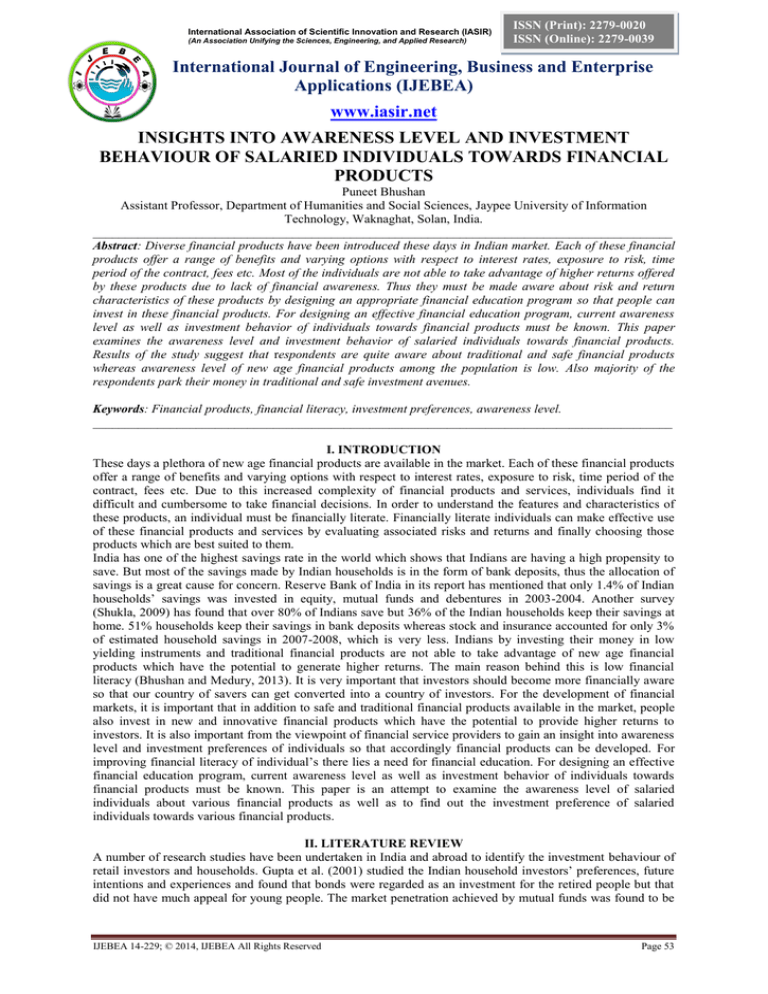
International Association of Scientific Innovation and Research (IASIR)
(An Association Unifying the Sciences, Engineering, and Applied Research)
ISSN (Print): 2279-0020
ISSN (Online): 2279-0039
International Journal of Engineering, Business and Enterprise
Applications (IJEBEA)
www.iasir.net
INSIGHTS INTO AWARENESS LEVEL AND INVESTMENT
BEHAVIOUR OF SALARIED INDIVIDUALS TOWARDS FINANCIAL
PRODUCTS
Puneet Bhushan
Assistant Professor, Department of Humanities and Social Sciences, Jaypee University of Information
Technology, Waknaghat, Solan, India.
__________________________________________________________________________________________
Abstract: Diverse financial products have been introduced these days in Indian market. Each of these financial
products offer a range of benefits and varying options with respect to interest rates, exposure to risk, time
period of the contract, fees etc. Most of the individuals are not able to take advantage of higher returns offered
by these products due to lack of financial awareness. Thus they must be made aware about risk and return
characteristics of these products by designing an appropriate financial education program so that people can
invest in these financial products. For designing an effective financial education program, current awareness
level as well as investment behavior of individuals towards financial products must be known. This paper
examines the awareness level and investment behavior of salaried individuals towards financial products.
Results of the study suggest that respondents are quite aware about traditional and safe financial products
whereas awareness level of new age financial products among the population is low. Also majority of the
respondents park their money in traditional and safe investment avenues.
Keywords: Financial products, financial literacy, investment preferences, awareness level.
__________________________________________________________________________________________
I. INTRODUCTION
These days a plethora of new age financial products are available in the market. Each of these financial products
offer a range of benefits and varying options with respect to interest rates, exposure to risk, time period of the
contract, fees etc. Due to this increased complexity of financial products and services, individuals find it
difficult and cumbersome to take financial decisions. In order to understand the features and characteristics of
these products, an individual must be financially literate. Financially literate individuals can make effective use
of these financial products and services by evaluating associated risks and returns and finally choosing those
products which are best suited to them.
India has one of the highest savings rate in the world which shows that Indians are having a high propensity to
save. But most of the savings made by Indian households is in the form of bank deposits, thus the allocation of
savings is a great cause for concern. Reserve Bank of India in its report has mentioned that only 1.4% of Indian
households’ savings was invested in equity, mutual funds and debentures in 2003-2004. Another survey
(Shukla, 2009) has found that over 80% of Indians save but 36% of the Indian households keep their savings at
home. 51% households keep their savings in bank deposits whereas stock and insurance accounted for only 3%
of estimated household savings in 2007-2008, which is very less. Indians by investing their money in low
yielding instruments and traditional financial products are not able to take advantage of new age financial
products which have the potential to generate higher returns. The main reason behind this is low financial
literacy (Bhushan and Medury, 2013). It is very important that investors should become more financially aware
so that our country of savers can get converted into a country of investors. For the development of financial
markets, it is important that in addition to safe and traditional financial products available in the market, people
also invest in new and innovative financial products which have the potential to provide higher returns to
investors. It is also important from the viewpoint of financial service providers to gain an insight into awareness
level and investment preferences of individuals so that accordingly financial products can be developed. For
improving financial literacy of individual’s there lies a need for financial education. For designing an effective
financial education program, current awareness level as well as investment behavior of individuals towards
financial products must be known. This paper is an attempt to examine the awareness level of salaried
individuals about various financial products as well as to find out the investment preference of salaried
individuals towards various financial products.
II. LITERATURE REVIEW
A number of research studies have been undertaken in India and abroad to identify the investment behaviour of
retail investors and households. Gupta et al. (2001) studied the Indian household investors’ preferences, future
intentions and experiences and found that bonds were regarded as an investment for the retired people but that
did not have much appeal for young people. The market penetration achieved by mutual funds was found to be
IJEBEA 14-229; © 2014, IJEBEA All Rights Reserved
Page 53
Puneet Bhushan, International Journal of Engineering, Business and Enterprise Applications, 8(1), March-May, 2014, pp. 53-57
much lower than equity shares for all age classes. Gupta and Jain (2008) on the basis of an all-India survey of
1463 households found the preferences of investors among the major categories of financial assets, such
as investment in shares, indirect investment through various types of mutual fund schemes, other investment
types such as exchange-traded gold fund, bank fixed deposits and government savings schemes. The study
provides interesting information about how the investors’ attitude towards various investment types are related
to their income and age, their portfolio diversification practices, and the over-all quality of market regulation as
viewed by the investors themselves.
Verma (2008) studied the effect of demographics and personality on investment choice among Indian investors
and found that mutual funds were popular amongst professionals, students and the self employed. Retirees
displayed their risk aversion by not investing in mutual funds and equity shares. It was also found that higher the
education, higher was the level of understanding of investment complexities. Graduates and above in
qualification preferred to invest in equity shares as well as mutual funds. Davar and Gill (2009) investigated the
underlying dimensions in the selection of different investment avenues for the households. The results of the
study revealed emphasis on familiarity, satisfaction, opinion and demographic dimensions for all investment
avenues. Geetha and Ramesh (2011) studied the Indian’s behaviour about investment preferences. The data for
their study was collected with the help of questionnaire and their total sample size was 210 respondents. They
studied the effect of demographic variables on investment preferences. The study found that people were not
aware about all the investment options available to them and they lack knowledge about securities.
Girdhari and Satya (2011) analysed the investment preferences of individuals in urban Orrisa (one of the states
in India). Through their study they found that investment decisions and risk tolerance of investors depends on
age, sex, income, marital status, education, family background and occupation. It was also found that male
investors are more risk seekers as compared to female investors. Das (2011) analysed the preferred investment
avenues of the households in Nagaon district of Assam. The findings of the study reveal that insurance products
are the most preferred investment avenues of the households. For carrying out this study, a structured
questionnaire was used. Education levels, awareness about the financial system, age of investors were found to
be the significant factors while making investment decisions. Income level was also found to be the important
factor which influences investment decisions. The results of the study shows that higher income group shows
relatively high preference towards investment in share market, conversely lower and average income group
shows keen preference towards insurance and banks as the most preferred investment avenues. Samudra and
Burghate (2012) studied the investment behavior of the middle class households in Nagpur. Bank deposits were
found to be the most popular instrument of investment followed by insurance. Small savings scheme such as
PPF, Post office savings deposits are the third preferred investment option. Amongst the factors which influence
the decision to invest in a particular instrument it was found that return from the investment ranks first.
Chaturvedi and Khare (2012) examined the investment pattern and awareness of the Indian investors about
different investment instruments. The results suggest that age, education, occupation and income level of the
individual affects their investment behaviour. Awareness of respondents towards traditional investment options
is much higher than that for corporate securities, mutual funds, equity shares and preference shares. They also
identified the factors which contribute to investor awareness. They found that occupation, education and income
level affects the awareness level of investors towards various investment avenues. Jain and Mandot (2012)
studied the impact of demographic factors on investment decisions of investors in Rajasthan, India. The
questionnaire was developed for this study and total sample of 200 investors from different cities of Rajasthan
has been taken for the purpose of the study. The study concludes that various demographic factors like age,
marital status, gender, city, income level, market knowledge, occupation and educational qualifications have
major impact on investment decision of investors in Rajasthan. Also it was found that gender and city have no
impact on investment decision of investors.
Sood and Medury (2012) analysed the investment preferences of working adults in Delhi, Gurgaon and Noida.
The results of their study showed that investment preferences are not affected by age, gender, income, marital
status and employment status. Bashir et al (2013) studied the investmnent preferences and risk level of salaried
individuals in Gujrat and Sialkot provinces of Pakistan. The results of the study suggests that females are more
risk averse than males whereas young and educated people are attracted more towards new risky investment
opportunities and want to invest money in these instruments but they hesitate because of limited resources and
lack of investment opportunities as well as absence of investment rends. Bhushan and Medury (2013) analysed
the gender differences in investment behavior of employees working in various universities of Himachal
Pradesh. India. They found that employees working in various universities of Himachal Pradesh invest in almost
all investment avenues available to them. There is an overall inclination of investing in safe investment
instruments. Gender differences in investment preferences are significant for health insurance, fixed deposits
and market investments.
After studying the literature on financial products it can be concluded that in India awareness towards traditional
investment options is much higher than for corporate securities, mutual funds, equity shares and preference
shares. Also the investment preference of individuals is more towards bank deposits and insurance products.
IJEBEA 14-229; © 2014, IJEBEA All Rights Reserved
Page 54
Puneet Bhushan, International Journal of Engineering, Business and Enterprise Applications, 8(1), March-May, 2014, pp. 53-57
1.
2.
III. OBJECTIVES OF THE STUDY
To examine the awareness level of salaried individuals about various financial products.
To find out the investment preference of salaried individuals towards various financial products.
IV. METHODOLOGY
For this study, Himachal Pradesh (a state in India) is taken as an area of study. All those salaried individuals of
Himachal Pradesh whether in government or non-government job were considered as the population for this
study. Primary data from the respondents was collected by using a structured questionnaire. Multistage sampling
has been adopted for collection of the data. There are total of twelve districts in Himachal Pradesh. Out of these
three districts namely Shimla, Solan and Kangra were selected randomly (first stage). The selected districts are
further divided on the basis of sub-divisions. In each of the selected districts further 2 sub-divisions were
selected randomly (second stage). From each selected sub-division, the required number of salaried individuals
was selected based on purposive sampling by using some criteria like place of work, occupational status and the
attitude of the respondents to cooperate for the study, so as to get the representative sample of the population.
Total sample of 516 respondents were used for the purpose of this study.
V. ANALYSIS AND DISCUSSION
Awareness regarding financial products
In order to find out the awareness level of respondents towards various financial products available in the
market, responses were measured on a 5 point Likert scale, assigning 1 to ‘very low’ awareness level and 5 to
‘very high’ awareness level. From the collected responses weighted mean for each of the financial product was
calculated . Based on the mean score, financial products were ranked giving 1 st rank to the financial product
whose mean score was highest and 14th rank to that product whose score was the least (Table 1). Results
indicate that highest awareness is for bank fixed deposits followed by savings account, life insurance, post office
savings, public provident fund, national savings certificate, kisan vikas patra, pension funds, mutual funds, stock
market, bonds, debentures, commodity market and forex market. Thus it can be clearly seen that respondents are
quite aware about traditional and safe financial products whereas awareness level of new age financial products
among the population is low. This points out to the fact that due to low awareness level people are not able to
take advantage of various financial products available in the market. Chaturvedi and Khare (2012) also found in
their study on Indian investors that awareness of respondents towards traditional investment options is much
higher than that for corporate securities, mutual funds, equity shares and preference shares.
Thus in order to strengthen our financial system, people must be made aware about the characteristics of new
age financial products. They must be made aware about risk and return characteristics of these products so that
people can invest in these financial products. This will strengthen our financial system. People will also get the
opportunity to invest in different financial products thereby increasing their chances of earning more returns
from their investments.
Table 1: Awareness of Financial Products
Percent
Count
Very High
Percent
High
Count
Percent
Count
Neutral
Percent
Low
Count
Percent
Count
Very Low
Mean
Rank
Savings Account
3
0.6
8
1.6
87
16.9
318
61.6
100
19.4
3.98
2
Bank Fixed Deposits
1
0.2
12
2.3
70
13.6
309
59.9
124
24.0
4.05
1
Public Provident Fund
13
2.5
46
8.9
196
38.0
177
34.3
84
16.3
3.53
5
Kisan Vikas Patra
17
3.3
111
21.5
196
38.0
135
26.2
57
11.0
3.20
7
National Savings Certificate
26
5.0
100
19.4
182
35.3
126
24.4
82
15.9
3.27
6
Post Office Savings
9
1.7
55
10.7
182
35.3
143
27.7
127
24.6
3.63
4
Pension Funds
25
4.8
156
30.2
142
27.5
110
21.3
83
16.1
3.14
8
Mutual Funds
52
10.1
109
21.1
193
37.4
124
24.0
38
7.4
2.97
9
Debentures
94
18.2
234
45.3
129
25.0
45
8.7
14
2.7
2.32
12
Bonds
89
17.2
209
40.5
135
26.2
67
13.0
16
3.1
2.44
11
Life insurance
13
2.5
26
5.0
94
18.2
291
56.4
92
17.8
3.82
3
Stock market
93
18.0
186
36.0
123
23.8
98
19.0
16
3.1
2.53
10
Commodity Market
238
46.1
190
36.8
42
8.1
36
7.0
10
1.9
1.82
13
Forex market
280
54.3
162
31.4
37
7.2
32
6.2
5
1.0
1.68
14
Source: Primary Data
IJEBEA 14-229; © 2014, IJEBEA All Rights Reserved
Page 55
Puneet Bhushan, International Journal of Engineering, Business and Enterprise Applications, 8(1), March-May, 2014, pp. 53-57
Investment preferences
Respondents have been asked to provide information about all those financial products where they have invested
their money. From their responses, it can be said that almost 95% of the respondents invest their money in bank
fixed deposits followed by 77.7% of respondents who invest in life insurance. 59.3% of respondents invest in
post office savings and almost 52.9% respondents invest in mutual funds (Table 2). Only 1.2 respondents invest
in commodity market and no respondent invests in forex market. The results are in line with Samudra and
Burghate (2012). In their study on investment behavior of the middle class households in Nagpur, bank deposits
were found to be the most popular investment instrument followed by insurance. Das (2011) found that
insurance products are the most preferred investment avenues of the households.
Table 2: Investment in Financial Products
Financial Products
Frequency
Percent of cases
490
95.0
Bank Deposits
306
59.3
Post Office Savings
273
52.9
Mutual Funds
159
30.8
Stock Market
11
2.1
Debentures
401
77.7
Life Insurance
202
39.1
Public Provident Fund
127
24.6
Pension Funds
52
10.1
Bonds
6
1.2
Commodity Market
516
Total Respondents
Source: Primary Data
From the analysis of the results it is clear that majority of the respondents park their money in traditional and
safe investment avenues. More people invest in mutual funds as compared to stock market. Results also indicate
that very few people invest their money in debentures as well as commodity market. Investment behaviour of
respondents investing in traditional investment avenues can be attributed to the fact that they are not aware
about the characteristics of new financial products, thereby loosing good investment opportunities. Results also
point out to the fact that only 24.6% respondents have invested in pension funds, which means most of the
people do not plan for retirement which is not a very healthy sign. Also 77.7% people have invested in life
insurance which means that people are aware about the importance of life insurance. Results also indicate that
only 39.1% respondents invest in public provident fund. This means that despite being a very good investment
option, only few people invest in public provident fund, this can be due to longer lock in period of public
provident fund and low level of awareness associated with public provident fund.
VI. CONCLUSIONS
Respondents are quite aware about traditional and safe financial products whereas awareness level of new age
financial products among the population is low. Majority of the respondents park their money in traditional and
safe investment avenues. Overall results suggest that people must be made more aware about new investment
opportunities available in the market. They must be properly educated about new financial products available in
the market, so that they can get advantage of earning higher returns. Moreover they will not get cheated by sales
personnel as they will have knowledge regarding the charges levied by a company selling financial products and
they will invest in financial products only after weighing risk return characteristics of the financial products.
REFERENCES
[1]
[2]
[3]
[4]
[5]
[6]
[7]
[8]
Bashir, T., Ahmed, H. R., Jahangir, S., Zaigam, S., Saeed, H., & Shafi, S. (2013). Investment preferences and risk level:
Behaviour of salaried individuals. IOSR Journal of Business and Management, 10(1), 68-78.
Bhushan, P., & Medury, Y. (2013). Gender differences in investment behaviour among employees. Asian Journal of Research
in Business Economics and Management. 3(12), 147-157.
Bhushan, P., & Medury, Y. (2013). Financial literacy and its determinants. International Journal of Engineering, Business and
Enterprise Applications, 4(2), 155-160.
Chaturvedi, M., & Khare, S. (2012). Study of saving pattern and investment preferences of individual household in India.
International Journal of Research in Commerce and Management, 3(5), 115-120.
Das, S.K. (2011). An Empirical analysis on preferred investment avenues among rural and semi-urban households. Journal of
Frontline Research in Arts and Science, 1, 26-36.
Davar, Y.P., & Gill, S. (2009). Antecedents of households’ investment decision-making process: A study of the Indian
households. South Asian Journal of Management, 16(4), 44-75.
Geetha, N., & Ramesh, M. (2011). A study of people’s preferences in investment behaviour, IJEMR, 1(6), 1-10.
Girdhari, M., & Sathya, S.D. (2011). A study on investment preferences among urban investors in Orrisa. Prerna – Journal of
Management Thoughts and Practices, 3(1), 1-9.
IJEBEA 14-229; © 2014, IJEBEA All Rights Reserved
Page 56
Puneet Bhushan, International Journal of Engineering, Business and Enterprise Applications, 8(1), March-May, 2014, pp. 53-57
[9]
[10]
[11]
[12]
[13]
[14]
[15]
Gupta, L. C., Gupta, C.P., &Jain, N. (2001). Indian Households’ Investment Preferences: A Survey. Society of Capital Market
Research and Development. Alankrit Printers, New Delhi.
Gupta, L.C., & Jain, N. (2008). Indian Households’ Investment Preferences: The Third All India investors’ Survey. Conducted by
Society for Capital Market Research and Development.
Jain, D., & Mandot, N. (2012). Impact of demographic factors on investment decision of investors in Rajasthan. Researchers
World – Journal of Arts, Science and Commerce, 3(2), 81-92.
Samudra, A., & Burghate, M.A. (2012). A Study on investment behaviour of middle class households in Nagpur. International
Journal of Social Sciences and Interdisciplinary Research, 1(5), 43-54.
Shukla, R. (2009). How India Earns, Spends and Saves. Study conducted by National Council of Applied Economic Research
(NCAER) and Max New York Life Insurance Company Ltd.
Sood, P. B., & Medury, Y. (2012). Investment preferences of salaried individuals towards financial products. International
Journal of Management and Behavioural Sciences, 1(1), 95-107.
Verma, M. (2008).Wealth management and behavioral finance: the effect of demographics and personality on investment choice
among Indian investors. The Icfai University Journal of Behavioral Finance, 5(4), 31-57.
IJEBEA 14-229; © 2014, IJEBEA All Rights Reserved
Page 57







